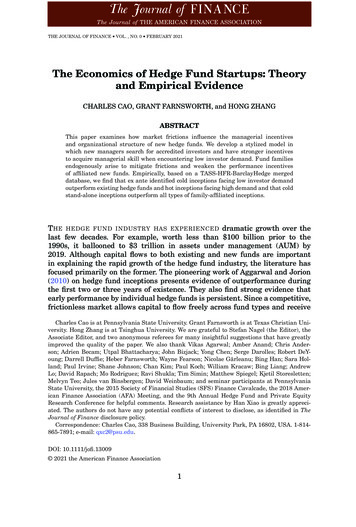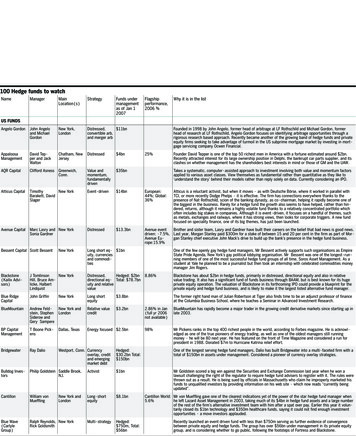
Transcription
THE JOURNAL OF FINANCE VOL. , NO. 0 FEBRUARY 2021The Economics of Hedge Fund Startups: Theoryand Empirical EvidenceCHARLES CAO, GRANT FARNSWORTH, and HONG ZHANGABSTRACTThis paper examines how market frictions influence the managerial incentivesand organizational structure of new hedge funds. We develop a stylized model inwhich new managers search for accredited investors and have stronger incentivesto acquire managerial skill when encountering low investor demand. Fund familiesendogenously arise to mitigate frictions and weaken the performance incentivesof affiliated new funds. Empirically, based on a TASS-HFR-BarclayHedge mergeddatabase, we find that ex ante identified cold inceptions facing low investor demandoutperform existing hedge funds and hot inceptions facing high demand and that coldstand-alone inceptions outperform all types of family-affiliated inceptions.THE HEDGE FUND INDUSTRY HAS EXPERIENCED dramatic growth over thelast few decades. For example, worth less than 100 billion prior to the1990s, it ballooned to 3 trillion in assets under management (AUM) by2019. Although capital flows to both existing and new funds are importantin explaining the rapid growth of the hedge fund industry, the literature hasfocused primarily on the former. The pioneering work of Aggarwal and Jorion(2010) on hedge fund inceptions presents evidence of outperformance duringthe first two or three years of existence. They also find strong evidence thatearly performance by individual hedge funds is persistent. Since a competitive,frictionless market allows capital to flow freely across fund types and receiveCharles Cao is at Pennsylvania State University. Grant Farnsworth is at Texas Christian University. Hong Zhang is at Tsinghua University. We are grateful to Stefan Nagel (the Editor), theAssociate Editor, and two anonymous referees for many insightful suggestions that have greatlyimproved the quality of the paper. We also thank Vikas Agarwal; Amber Anand; Chris Anderson; Adrien Becam; Utpal Bhattacharya; John Bizjack; Yong Chen; Serge Darolles; Robert DeYoung; Darrell Duffie; Heber Farnsworth; Wayne Fearson; Nicolae Gârleanu; Bing Han; Sara Holland; Paul Irvine; Shane Johnson; Chan Kim; Paul Koch; William Kracaw; Bing Liang; AndrewLo; David Rapach; Mo Rodriguez; Ravi Shukla; Tim Simin; Matthew Spiegel; Kjetil Storesletten;Melvyn Teo; Jules van Binsbergen; David Weinbaum; and seminar participants at PennsylvaniaState University, the 2015 Society of Financial Studies (SFS) Finance Cavalcade, the 2018 American Finance Association (AFA) Meeting, and the 9th Annual Hedge Fund and Private EquityResearch Conference for helpful comments. Research assistance by Han Xiao is greatly appreciated. The authors do not have any potential conflicts of interest to disclose, as identified in TheJournal of Finance disclosure policy.Correspondence: Charles Cao, 338 Business Building, University Park, PA 16802, USA. 1-814865-7891; e-mail: qxc2@psu.edu.DOI: 10.1111/jofi.13009 2021 the American Finance Association1
2The Journal of Finance comparable risk-adjusted returns (see Berk and Green (2004), Berk and vanBinsbergen (2015, 2017)), these findings raise important questions: do marketfrictions hinder the flow of capital in the hedge fund industry and, if so, dothese frictions shape the managerial incentives and organizational structuresof the hedge fund industry.In this paper, we address these questions by analyzing one of the most important types of market frictions faced by new hedge fund managers, namely,the need to search for accredited investors. Prior work shows that search frictions are important for mutual funds (see Sirri and Tufano (1998), Choi, Laibson, and Madrian (2010) for empirical evidence and Hortaçsu and Syverson(2004), Gârleanu and Pedersen (2018) for theoretical treatments). Becausehedge funds face many marketing restrictions, search frictions may play aneven more important role for these funds. However, the burden of search forhedge funds differs from that of mutual funds: instead of investors using public information to search, as discussed in mutual fund studies, new hedge fundmanagers often must find accredited investors and persuade them to invest.We develop a stylized model in which we incorporate into the model of Berkand Green (2004) the need for a new manager to raise capital. In the spirit ofRubinstein and Wolinsky (1985) and Duffie, Gârleanu, and Pedersen (2005,2007), we model fund-raising as a two-step search-and-bargaining process.This framework delivers several novel predictions and sheds light on the critical role played by search frictions in the hedge fund industry. The need tosearch for investors not only influences managerial incentives of new fundsbut also drives the formation of fund families.To see how search frictions influence managerial incentives, we note thatthe total capital raised is determined by two margins: the extensive margin,which refers to the investors and initial capital that the manager identifiesvia search, and the intensive margin, the fraction of capital that the managerretains after bargaining with the investors. While the extensive margin is related primarily to investor demand, the intensive margin can be influenced bythe merit of the fund: by investing in costly credible skills necessary to deliversuperior (expected) performance, the manager can persuade a larger fractionof matched investors to contribute.Importantly, the two margins act as substitutes, which impacts managerialincentives. A high extensive margin reduces a manager’s incentive to use superior performance to persuade investors in the bargaining step. A novel andtestable implication arises. If we refer to new funds launched using a “hot”strategy (i.e., a hedge fund strategy that is popular among investors at thetime) as hot inceptions and those launched using a “cold” strategy (an unpopular strategy) as cold inceptions, our model predicts that cold inceptions shouldoutperform hot inceptions.Search frictions also provide an economic rationale for a key organizationalfeature of the industry: hedge fund families. Two types of family-affiliated inceptions arise in our model. First, family structures emerge to allow affiliatednew funds to benefit from existing funds’ investor pool. These investors mayinvest in the new fund or may introduce other accredited investors to the fund.
The Economics of Hedge Fund Startups3The latter networking effect reduces new funds’ search costs and is consistentwith the effects of social networks (e.g., Jackson and Rogers (2007)). However,the search advantage provided by family structures reduces the performanceincentive of affiliated new managers. Our model therefore predicts that familyaffiliated inceptions deliver poorer performance than stand-alone inceptions.The second channel giving rise to family-affiliated inceptions is diseconomiesof scale, a widely observed feature of hedge funds. In our model, search frictionsamplify diseconomies of scale. Thus, when investor demand for existing fundsexperiences a positive shock, fund families have incentives to launch clone inceptions that closely mimic existing funds to absorb the excess demand. Cloneinceptions are de facto hot and unlikely to contribute new skills and deliversuperior performance.We test these model predictions using a comprehensive sample of hedgefunds that we obtain by merging three leading commercial hedge funddatabases—Lipper TASS, HFR, and BarclayHedge—over the period 1994 to2016. Specifically, we conduct three tests to investigate the performance difference between cold and hot inceptions.First, we exploit variation in the popularity of hedge fund strategies amonginvestors. Since investors chase past performance, we use recent strategy returns and flows to capture strategy popularity. Empirically, we find that coldinceptions deliver better performance than both existing funds and hot inceptions. Over the 60-month holding period after initial inception, cold inceptionsoutperform hot inceptions by 0.24% per month (or 3% annually) on a riskadjusted basis.Second, we explore the role of hedge fund families. We find that stand-aloneinceptions outperform family-affiliated inceptions by 0.23% per month (or 2.8%per year) on a risk-adjusted basis. For family-affiliated nonclone funds, coldinceptions outperform hot ones by 4.3% annually. In contrast, we do not find aperformance difference between cold and hot clone inceptions.The above results suggest that an empirical strategy combining cold standalone and hot clone inceptions will have the most power to identify the effects ofextensive-margin advantages because this strategy incorporates the influencesof both strategy demand and family structure. The performance gap betweencold stand-alone inceptions and hot clone inceptions is as high as 0.55% permonth (or 6.8% annually), which is statistically and economically significant.Due to its appealing economic interpretation, we adopt this empirical strategyin several tests below. The results provide strong support to the predictionthat superior-performing new hedge funds can be identified ex ante based onan understanding of the effects of investor demand and family structures.Since our model applies best to new fund managers (experienced managersmay have access to more investors), we also conduct a test focusing on theinceptions of new managers. To do so, we exclude inceptions run by managerswho have previously managed other funds. The results using this sample aresimilar to those of our main tests but have larger economic magnitudes.We next examine the economic source of cold inceptions’ outperformance. Inour model, superior performance is driven by investment in managerial skills.
4The Journal of Finance However, a leading concern about hedge fund performance is that greaterexposure to illiquidity or deliberate return-smoothing may allow some fundsto inflate performance (e.g., Getmansky, Lo, and Makarov (2004)). We conducta battery of tests to investigate the source of the performance difference between cold and hot inceptions and the extent to which it reflects genuine skill.We first examine the security-selection and market-timing skills (e.g.,Treynor and Mazuy (1966)) of cold and hot inceptions. We find that managersof cold inceptions exhibit significant skill in security-selection but no skill inmarket-timing. In contrast, managers of hot inceptions demonstrate negative(incorrect) market-timing ability and weaker selection skill, with the net effectthat they do not deliver alpha.Next, since persistence analysis provides a powerful test for managerial skill(e.g., Carhart (1997)), we examine whether there is any difference in performance persistence between cold and hot inceptions. We find that the performance of cold inceptions is highly and significantly persistent over time, whilehot inceptions exhibit negative or insignificant persistence.Finally, we show that the performance gap between hot and cold inceptionscannot be attributed to illiquidity or return-smoothing. Additionally, it cannotbe explained by risk factors beyond the Fung and Hsieh (2004) seven factors, byfund characteristics, or by fund policy choices. Rather, our subsample analysisof convertible arbitrage (CA) funds suggests that cold inceptions exploit moresophisticated economic sources than market-wide risk or well-known arbitrageopportunities.Backfill bias is an important concern in hedge fund research. It arises whenmanagers joining a database have the option of reporting performance betweeninception and the initial report date. Because funds may not report if early performance is poor, reported returns from the backfill period exhibit an upwardbias. To account for this bias, in all tests we use the approach of Jorion andSchwarz (2019) to identify the add dates and we delete all observations beforethis date.This study builds on and extends the work of Aggarwal and Jorion (2010),who use a novel event-time approach and careful controls for backfill bias toshow that new funds deliver alpha and performance persistence during thefirst two to three years. Their findings highlight the importance of new talent entering the industry but also strongly suggest that market frictions exist that hinder the efficiency of capital flows to new funds. Sun, Sun, andZheng (2020) study whether investor sentiment affects the decision to startnew funds and document a significant positive impact. We develop a model toexplore these issues and show that search frictions affect portfolio management through family structure and negative demand-performance incentives.Both mechanisms are novel to the literature and play an important role indetermining the cross-section of new hedge fund performance. Unlike in Aggarwal and Jorion (2010), these mechanisms lead us to explore and documentsignificant performance heterogeneity across various types of hot and coldinceptions.An emerging literature examines the influence of market frictions, particularly search frictions, on delegated portfolio management. Theoretical
The Economics of Hedge Fund Startups5treatments of search frictions concentrate on the costs that investors bear insearching for funds (e.g., Hortaçsu and Syverson (2004), Gârleanu and Pedersen (2018)).1 We complement these studies by examining the influence of newhedge fund managers’ need to search for accredited investors. Building on thework of Berk and Green (2004) and the search framework of Rubinstein andWolinsky (1985) and Duffie, Gârleanu, and Pedersen (2005, 2007), we showthat this friction critically influences the incentives of new managers and theorganizational structure of the industry. Our model is tractable and its predictions are consistent with the data.Finally, this study extends the literature on hedge fund and mutual fundfamilies. Although family structures are widely observed in both hedge fundand mutual fund industries, the underlying economic rationales differ betweenthese industries. Our model suggests that hedge fund families can arise tomitigate search frictions or to address search-enhanced diseconomies of scale.The predictions of the model are supported in our empirical findings.The remainder of the paper proceeds as follows. Section I presents a modelof hedge fund inceptions and its testable hypotheses. Section II describes thehedge fund data that we use in our analysis. Section III examines the determinants of hedge fund inception probability. Section IV studies the influence ofstrategy demand and family structure on the performance of inceptions. Section V explores alternative explanations for our findings. Finally, Section VIconcludes.I. Theoretical Framework for Hedge Fund InceptionsIn this section, we develop a stylized model of hedge fund startups. We extend the model of Berk and Green (2004; hereafter, BG) by incorporating a keyfeature that affects hedge fund inceptions, namely, managers’ need to searchfor accredited investors.2A. The BG Benchmark of Existing Funds in the Same Strategy CategoryBefore we examine the launch of a new fund in a given strategy, we describeexisting funds in the same strategy category. For tractability, existing fundsin the strategy are represented by a benchmark fund whose operation and1 Hortaçsu and Syverson (2004) show that investors’ search costs help explain the puzzling feedispersion among S&P 500 index funds. Gârleanu and Pedersen (2018) examine the asset pricingimplications of an extended Grossman-Stiglitz (1980) model in which investors search for mutualfunds. In addition to search frictions, Jylhä and Suominen (2011) show that, in a two-countrymodel, hedge funds arise endogenously to mitigate market segmentation, while Glode and Green(2011) model the bargaining process between hedge fund managers and investors.2 Indeed, raising money is widely regarded as one of the most difficult tasks of a new hedgefund (see, e.g., the discussion on how to start a hedge fund at d/). In practice, new managers often need to actively search for potential investors, for instance, through networking. Even when potential accredited investors are found,it is not an easy task to raise capital, as many such investors have professional teams to aid investment (e.g., the family office of wealthy families).
6The Journal of Finance dynamics follow BG, except for an additional search term that we specify below.Although the BG model was originally designed for mutual funds, its two keyfeatures—diseconomies of scale in fund operation and the equilibrium of theindustry achieved through fund size—apply well to the hedge fund industry.In particular, as Berk and van Binsbergen (2015, 2017) point out, the marketfor mutual funds equilibrates in quantity as the price for funds is fixed by themarket value of the funds’ underlying assets. In that context, fund size proxiesfor managerial skill. In our model, the hedge fund industry achieves a similarequilibrium with an additional key influence—search frictions.Following the notation of BG, we assume that in a given investment period t,a benchmark hedge fund is endowed with the skill to generate a risk-adjustedstrategy benchmark return of Rt , with expected value φt 1 , which is observableto investors.3 Further, we assume that the fund distributes a cost-adjusted return of rt Rt c(qtE ) s(qtE ), where qtE denotes fund size of existing funds,E. The variable c(qtE ) b qtE f is the fund-size-normalized cost functionfollowing Berk and van Binsbergen (2015, 2017), where b and f denote operational costs (with diseconomies of scale) and management fees.4 The last term,s(qtE ), we introduce in the model to describe the size-normalized search costthat the fund incurs to raise capital qtE . The search cost can be thought of asa networking and marketing cost that can be deducted from the payoff of thefund (we specify the cost below).When investors receive zero net-of-fee returns, we have the following searchenhanced BG equilibrium condition (hereafter, the BG condition): E (rt 1 ) φt c qtE s qtE 0.(1)This condition says that the fund industry equilibrates in fund size and thatthe fund manager earns the economic rents that she creates. We assume thissplit of the benchmark fund’s economic rents to highlight new funds’ incentive problem. Adjusting the split will not affect the incentive difference acrossdifferent types of funds.To model managerial incentives, we follow BG and assume that a fund manager benefits from more capital: she derives a utility gain of g(qt ) f q(t) bymanaging a fund of size q(t). Here, we remove the superscript E because theutility applies to both new and existing funds. At the same time, the managercan enhance a fund’s expected risk-adjusted return by δ if she pays a linear3 More explicitly, the fund can generate a risk-adjusted return of R α , where α ttN(φ0 , η2 ), based on known information, denotes the performance of the strategy (i.e., risk-adjusted2return funds in this strategy category deliver) and t N(0, σ ) is noise. Investors do not observethe true distribution of managerial skill. Rather, they use the realized return to update their prior,and expect that the benchmark fund will deliver an expected return of φt 1 E(Rt Rt 1 , . . . , R1 )in period t.4 BG assumes that the dollar cost of operation exhibits diseconomies of scale; c(qE ) is the dollartcost scaled by fund size.
The Economics of Hedge Fund Startups7private learning cost, L(δ) L0 δ, where L0 is a positive coefficient.5 Themanager can then deliver δ to investors to attract more capital.6The trade-off between the marginal benefits and marginal costs determinesthe optimal level of performance that the manager wants to deliver. Althoughthis trade-off resembles BG, the critical difference is that fund managers alsoface search frictions, which we examine next.7B. Capital-Raising as a Search-and-Bargaining ProcessSearch can go in two directions: investors can search for managers, and managers can search for investors. A close look at an investor-search BG modeland its comparison to the data (see Section II of the Internet Appendix) suggests that new hedge funds may benefit from actively reaching out to investors,giving rise to manager-initiated search. We therefore adopt the search framework of Rubinstein and Wolinsky (1985) and Duffie, Gârleanu, and Pedersen(2005, 2007) to examine how manager-initiated search affects the incentivesof new funds.8 To do so, we introduce three sets of assumptions that help extend BG under these frictions: investor heterogeneity in supplying capital tohedge funds, capital-raising as a search-and-bargaining process, and familyaffiliation as a source of capital.We first describe investor heterogeneity and capital. For a given category,its full set of existing and potential investors can be classified into four types,denoted by {ho, hn, lo, ln}, based on two sets of characteristics: “h” (high)and “l” (low) refer to an investor’s intrinsic preference for the hedge fund strategy (i.e., investors with a high (low) preference are willing (unwilling) to investin hedge funds in that strategy), while “o” and “n” refer to “old” investors ofthe existing fund and noninvestors who have not invested. For instance, “hn”refers to investors who have not invested in the existing fund of the strategybut are willing to do so if a fund in that strategy solicits capital from them.We normalize the total mass of all investors to one (there is a continuumof investors) and assume that investors carry with them an amount of capital to invest in period t, z(t). The variable z(t) describes investors’ aggregatedemand for the strategy, which is exogenous to the new fund by assumption.Hence, if we denote the fraction of type-σ investors (σ ) by μσ (t), such that5Although learning costs are often assumed to be convex, this assumption is not necessary inour model because the benefit of learning is concave in alpha. Having convex learning costs doesnot affect our main conclusions, as we will see below.6 The fund can of course distribute only a fraction of alpha to investors and use the remainingalpha either to enlarge fund size as in the BG condition or it can retain the remaining alpha asincentive fees. The Internet Appendix shows that our main predictions remain valid in these cases.The Internet Appendix is available in the online version of this article on The Journal of Financewebsite.7 Another difference is that hedge funds can use leverage, which we do not explicitly examinein this paper. Hence, we can interpret qt as leverage-adjusted fund size when hedge funds havealready taken the maximum amount of leverage. We thank the Associate Editor for this intuition.8 Duffie (2010) provides more discussions on the mechanisms of imperfect move of capital.
8The Journal of Finance μho (t) μhn (t) μlo (t) μln (t) 1, we can interpret μσ (t) as the mass of typeσ investors, who carry with them μσ (t) z(t) of capital.Next, we assume that capital-raising occurs at the beginning of period t,during which the existing fund and a new fund sequentially raise capital. Theexisting fund moves first. Once its steady state (characterized by stabilizedμσ (t)) is achieved, the fund collects capital from its investors (i.e., of type σ {ho, lo}).9 The new manager then seeks to raise capital from the remaininginvestors in the market (i.e., of type σ {hn, ln}). Both funds invest the capitalraised during the period and deliver cost-adjusted payoffs to investors at theend of the period.We explicitly model capital-raising as a search-and-bargaining procedure.Take the new fund as an example. In the search step, the new manager triesto find investors in the market. We assume that by paying a total searchcost of TS, a new fund can be matched with investors with an intensity ofρ N , where the superscript N denotes new funds, and paying a higher searchcost allows the manager to be matched with a higher intensity of investors,that is, ρ N a TS, where a is a positive constant. The extensive margin ofcapital-raising is then the total amount of matched capital in the search step,ρ N (μhn (t) μln (t))z(t).Next the new manager bargains with investors, trying to persuade themto invest. Of matched investors, the hn-type will immediately invest due totheir high intrinsic preference, but ln-type investors are unwilling to do so.However, the manager can use her fund-specific performance, δ, to bargain.Since ln-investors receive an expected abnormal return of δ, traditional financial theories (e.g., the CAPM) suggest that their optimal asset allocation in thenew fund would be in proportion to δ. Hence, without loss of generality, we assume that ln-investors can be persuaded with probability ξ (δ) ξ0 δ, ξ0 0,which allows the manager to raise capital in the amount of ρ N μln (t)ξ (δ)z(t)from ln-investors.10 Superior performance, therefore, increases the fraction ofcapital that the manager can retain under the intensive margin of the capitalraising process.9 Note that the value of μ (t) is determined in the steady-state by the expected performanceσφt of the existing fund, the search cost it pays, and the probabilities of h- and l-type investorsswitching preferences—we provide details on the search process and the steady-state of the oldfund in Lemma IA.2 in the Internet Appendix. For now, we note that investors remain in themarket from whom the new fund can raise capital.10 There is no information asymmetry about δ in our model. It is worth noting that the secondstep in our model is equivalent to the bargaining process of a typical search-based asset pricingmodel in determining the equilibrium conditions. The difference is that in asset pricing modelsinvestors typically bargain for price (e.g., Duffie, Gârleanu, and Pedersen (2005, 2007)), whilein our model the manager bargains for the quantity of capital to be invested when the price isfixed. This notion of bargaining (for capital) is consistent with both the BG equilibrium conceptand the take-it-or-leave-it Nash bargaining models widely used in the search literature (see, e.g.,McMillan and Rothschild (1994) for a survey on such models). The Internet Appendix (at the endof the proof of Lemma 3) sketches a general search framework that generates the assumptionof having two types of investors with heterogeneous intrinsic preferences and the assumption ofincreasing bargaining power based on superior performance.
The Economics of Hedge Fund Startups9In economic terms, the search and bargaining steps capture the extensiveand intensive margins of the capital-raising process, during which a total ofρ N (μhn (t) μln (t)ξ (δ))z(t) can be raised. When the amount of capital is greaterthan or equal to the optimal fund size, q(t), the manager stops searching andlocks in the capital for investment:ρ N (μhn (t ) μln (t ) ξ (δ )) z (t ) q (t ) .(2)The capital-raising process above applies to both new and existing funds.Notably, the existing fund has an advantage of existing investors for which itssearch cost is zero. Thus, it searches for new investors as a replacement forwithdrawals by existing investors. In contrast, the burden of new funds is tofind all new investors. When the search process is costly, this difference givesrise to performance heterogeneity across funds.If the existing fund benefits from its existing investors, a family structurecan endogenously arise to allow some new funds to benefit from these investorsas well. To capture this effect, we assume that new hedge funds can be eitherstand-alone or affiliated with the existing fund through a family structure, andwe separately examine the incentives and performance of these two types ofnew funds. We assume that a family structure enhances the mass of high-type (t) μhn (t) investors available to its affiliated new managers, that is, μNhnEEγh μho (t), where μho (t) is the high-type investors of the existing fund and γh ( 0)describes the networking effect of the existing investors in supplying capital,referring new investors, and providing relevant information.11Conditioning on the additional assumptions above, a fund manager maximizes her utility by optimizing search cost and fund-specific performance asfollows:max U (s (t ) , δ ) g (qt ) L (δ )s(t), δ(3)s.t. (1) and (2).C. The Incentives of Stand-Alone New Funds in Generating Fund-SpecificAlphaWe first derive a closed-form solution to the managerial problem of standalone inception. Easy access to capital during the search step of the fundraising process (a high extensive margin) influences the incentive to generateextra performance. The extensive margin is associated with investor demand,z(t), which is exogenous to the new fund. The impact of demand on managerialincentives is as follows.11 Existing investors may also help managers reduce the intensity of low-type investors, that is, (t) μN(t) γl μE(t), where γl is a positive parameter. Adding this effect does not affect ourμNlolnlnmain conclusions.
10The Journal of Finance PROPOSITION 1: When a new manager solves the general problem (3) subjectto the conditions specified in (1) and (2), the following properties hold:(i) Theoptimalleveloffund-specificalphaisδ 1 12μ(t)Max{0, f 2 (L0 bμln (t)ξ0 azt ) μlnhn(t)ξ0 }.(ii) When the new manager encounters high investor demand, that is, alarger value of z(t), the level of fund-specific alpha δ decreases as afirst-order effect.(iii) Having a convex learning cost does not affect property (ii).The extensive margin has a profound effect on the incentive of new managersto generate additional performance. When new managers encounter high investor demand in the search phase (i.e., when z(t) is high), the incentive formanagers to generate additional performance to retain matched investor capital (the intensive margin) declines.12 The interplay between the exten
funds that we obtain by merging three leading commercial hedge fund databases—Lipper TASS, HFR, and BarclayHedge—over the period 1994 to 2016. Specifically, we conduct three tests to investigate the performance differ-ence between cold and hot inceptions. First, we exploit variation in the popularity o










